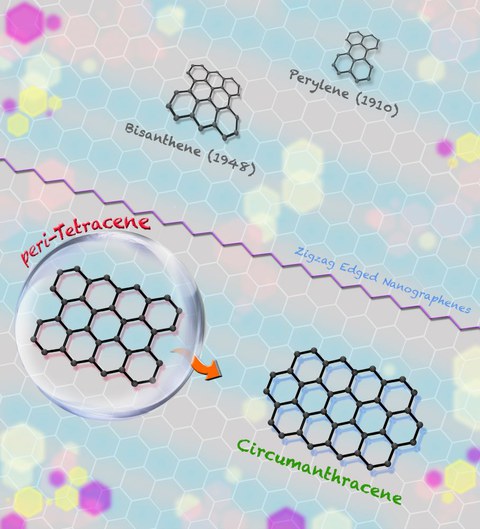08.05.2018
Toward Full Zigzag-Edged Nanographenes: peri-Tetracene and Its Corresponding Circumanthracene
Story of peri-acene (n-PA) molecules started one century ago. Apart from perylene (R. Scholl, 1910) and bisanthene (E. Clar, 1948), all n-PAs are theoretically predicted to show singlet biradical ground state (open-shell), and, hence unstable under ambient conditions. After several decades of waiting, recently, researchers from Technische Universität Dresden (Chair for Molecular Functional Materials, cfaed) and collaborators tackle the synthetic challenges to realize peri-tetracene (4-PA), the next higher analogue, in solution via steric-protection of its active zigzag edges.
This work has been published in Journal of the American Chemical Society (J. Am. Chem. Soc., 2018, DOI: 10.1021/jacs.8b03711). The authors demonstrated the synthesis and characterization of the hitherto unknown 4-PA by a rational bottom-up strategy. The phenyl substituents at the zigzag periphery of 4-PA not only offer stability, but also enhance its solubility in common organic solvents. The obtained 4-PA possesses a singlet biradical character (y0 = 72%) and exhibits remarkable persistent stability with a half-life time (t1/2) of ∼3 h under ambient conditions. UV–vis–NIR and electrochemical measurements reveal a narrow optical/electrochemical energy gap (1.11 eV) for 4-PA. Moreover, the bay regions of 4-PA enable the efficient 2-fold Diels–Alder reaction, yielding a novel full zigzag-edged circumanthracene (CA).
This work was financially supported by ERC grants on 2DMATER, the European Union’s Horizon 2020 research and innovation programme under grant agreement No 696656 (Graphene Flagship Core1), Center for Advancing Electronics Dresden (cfaed), European Social Fund and the Federal State of Saxony (ESF-Project “GRAPHD”, TU Dresden). J.J.W. thanks the DFG for funding a Rigaku Oxford Diffraction SuperNova system with a dual source (INST 269/618-1). The authors acknowledge the use of computational facilities at the Center for information services and high performance computing at TU Dresden.
Reference:
M. R. Ajayakumar, Y. Fu, J. Ma, F. Hennersdorf, H. Komber, J. J. Weigand, A. Alfonsov, A. A. Popov, R. Berger, J. Liu, K. Müllen, X. Feng, J. Am. Chem. Soc., 2018, DOI: 10.1021/jacs.8b03711).

